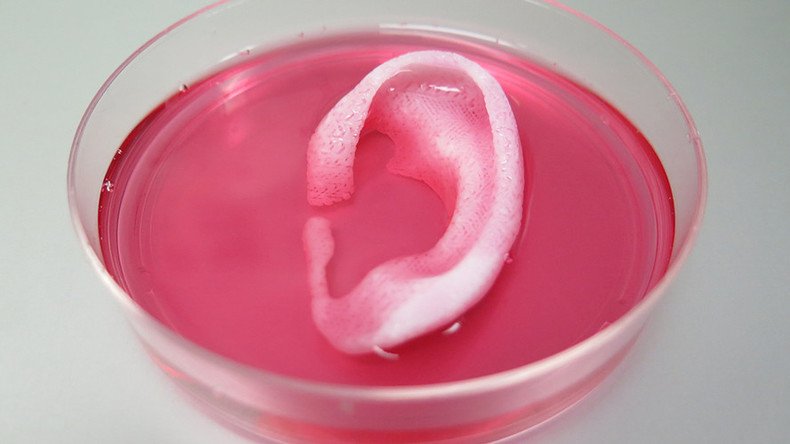Scientists have used 3D-printing technology to create first-of-their-kind structures made of living tissue. The bioprinter breakthrough has shown promise with cartilage, bone and muscle, opening the prospect of creating replacement human body parts.
Researchers using a bioprinter, described Monday in Nature Biotechnology, say that they’ve found a way to manufacture living muscle, bone and cartilage. They say that this technology can make unprecedented advances in the healing of battlefield injuries by using a combination of living cells and a plastic-like material.
READ MORE: Human organ transplants could be 3D-printed in 15 years – Russian researchers
While printed tissue has been accomplished before, scientists have not figured out a way to nourish the tissues by allowing blood vessels to colonize them after they are transplanted.
“Cells simply cannot survive without a blood vessel supply that’s smaller than 200 microns [0.07 inches], which is extremely small,” Atala told Gizmodo. “That’s the maximum distance. And that’s not just for printing, that’s nature.”
So far, the manufactured body parts have only been tested on laboratory animals, but the transplants were stable enough to be considered successful in those tests.
“It can fabricate stable, human-scale tissue of any shape,” Anthony Atala, director of the Wake Forest Institute for Regenerative Medicine in North Carolina, said in a statement. “With further development, this technology could potentially be used to print living tissue and organ structures for surgical implantation.”
The groundbreaking bioprinter creates the custom organs by layering patterns of artificial, biodegradable plastic-like material that contains cells from the patient who will receive the implant. Then the device adds a temporary shell that scaffolds the structure together while it is put into the host’s body. The artificial materials then slowly degrade while the cells grow strong enough to support themselves.
“Our results indicate that the bio-ink combination we used, combined with the microchannels, provides the right environment to keep the cells alive and to support cell and tissue growth,” Atala said.
READ MORE: Breakthrough in 3D-printing? MIT unveils device molding 10 materials at once
To test the body parts, scientists printed human-sized ears and grafted them to mice and witnessed the circulation of blood and formation of cartilage tissue within two months. They also implanted muscle tissue in rats and noted that nerves began to form within two weeks. Bone implants, which were printed using human stem cells and implanted in rats, triggered the formation of a blood vessel system that could be observed after five months.
While it has yet to be used in humans, Atala and his colleagues say that the bioprinter’s principles are the same in people as they are in animals. Replacement pats can be made to order based on 3D body scans, they said.

